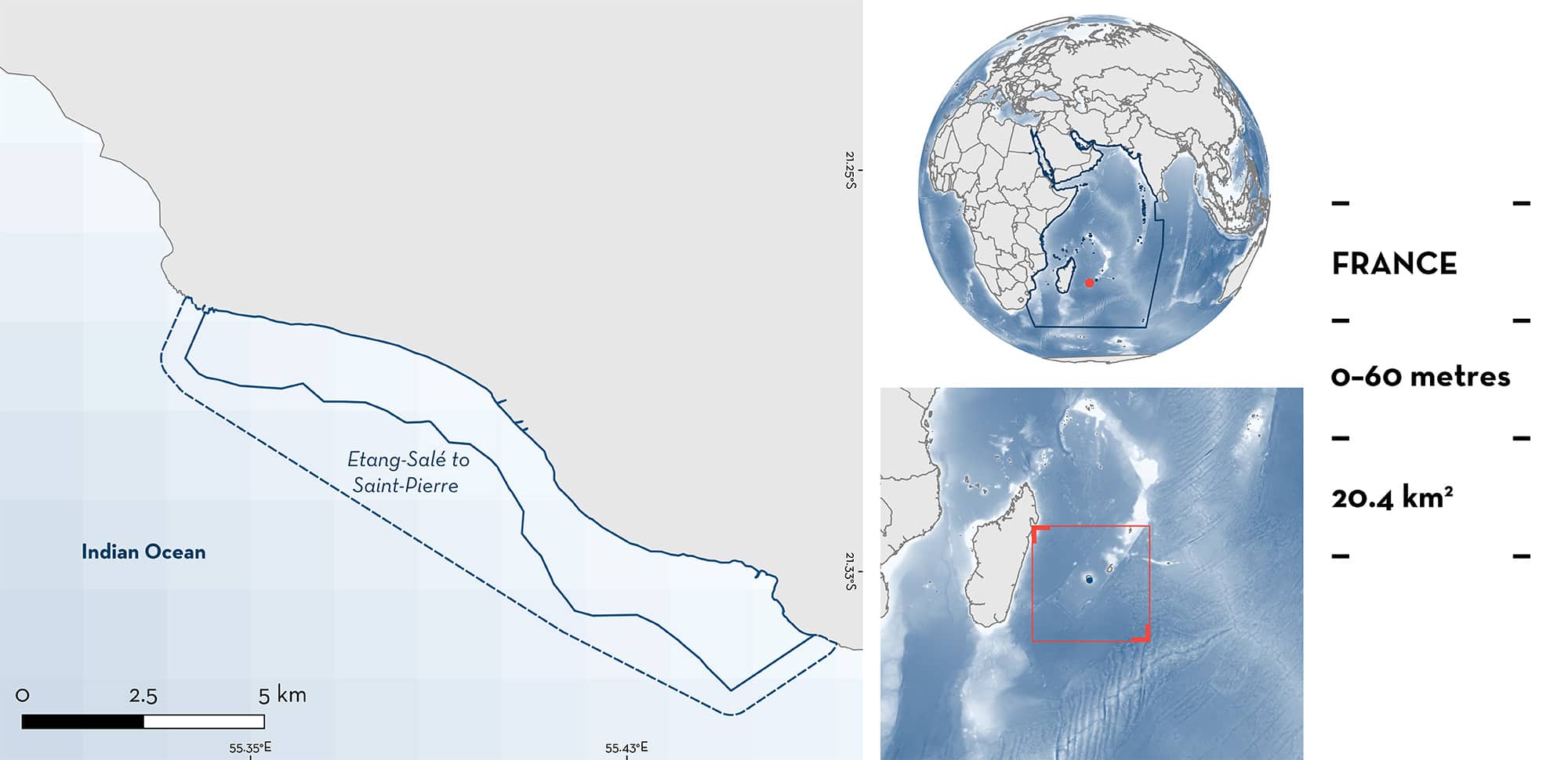ISRA FACTSHEETS
ISRA FACTSHEETS
WESTERN INDIAN OCEAN REGION
Etang Salé to Saint-Pierre
Summary
Etang-Salé to Saint-Pierre is on the southwest coast of Reunion Island. This area is located on a narrow shelf and is affected by temporary freshwater input from the Saint-Etienne River. The seabed is mostly volcanic basalt rock with sediments of diverse grain size and small reef banks. This area partly overlaps with the National Marine Nature Reserve of Réunion Island protected area and with La Réunion Marine Natural Reserve Key Biodiversity Area. Within this area, there are: threatened species (e.g., Bull Shark Carcharhinus leucas); reproductive areas (Scalloped Hammerhead Sphyrna lewini); and undefined aggregations (Bull Shark).
Download factsheet
Etang Salé to Saint-Pierre
DESCRIPTION OF HABITAT
Etang-Salé to Saint-Pierre is on the southwest coast of Reunion Island. Reunion Island is affected by sporadic oceanic swells generated by tropical cyclones (occurring mainly during the austral summer, from November to March) or by winter austral swell events (from April to October; Rindraharisaona et al. 2020). This area is sheltered from tropical cyclones but not from austral swell events. The summer season is warm (average annual Sea Surface Temperature [SST] is 28°C) with heavy rains, while the winter is cooler (SST = 23°C) with infrequent rain (Conand et al. 2008).
Within this area lies the mouth of the largest river of the western coast of Reunion Island, the Saint-Etienne River. The shelf is narrow (maximum 2 km wide) and quickly descends to the abyssal plain. The seabed belongs to the alluvial complex of the Saint-Etienne River and is mostly made of volcanic basalt rocks with sediments of diverse grain size that originate from terrestrial run-off. Two small reef banks are present in the area at 0–30 m depth, one in the north and the other in south (Marex 2021).
This area partially overlaps with the National Marine Nature Reserve of Réunion Island and with La Réunion Marine Natural Reserve Key Biodiversity Area (KBA 2023).
This Important Shark and Ray Area is benthopelagic and is delineated from surface and inshore waters (0 m) to 60 m depth based on the bathymetry of the area.
CRITERION A
VULNERABILITY
Two Qualifying Species considered threatened with extinction according to the IUCN Red List of Threatened SpeciesTM regularly occur in the area. These are the Critically Endangered Scalloped Hammerhead (Rigby et al. 2019) and the Vulnerable Bull Shark (Rigby et al. 2021).
CRITERION C
SUB-CRITERION C1 – REPRODUCTIVE AREAS
Etang-Salé to Saint-Pierre is an important reproductive area for one shark species.
Between January 2016 and December 2021, four private Facebook groups of local recreational fishers with large memberships (3,300–19,700 members) were surveyed (Jaquemet et al. 2023). Group postings were examined daily to gather all information in relation to catches of sharks and rays. Results from this survey showed that between 2015–2023, Scalloped Hammerhead neonates and young-of-the-year (YOY) were captured, representing 17.8% of all catches reported from 15 localities around Reunion Island (Jaquemet et al. 2023). A total of 32 Scalloped Hammerheads measuring <100 cm total length (TL) were reported captured by these groups. The reported size-at-birth for Scalloped Hammerhead is 31–57 cm TL (Ebert et al. 2021). Most catches were recorded in the summer, during the rainy season, and close to the Saint-Etienne River mouth. In addition, recreational fishing data from fishers operating from shore throughout Reunion Island over the last decade showed that this area has the third highest catch of Scalloped Hammerhead and that these catches included neonates and/or YOY individuals (Université de la Réunion 2023). This included four individuals which measured <50 cm TL, two of 67 and 80 cm TL, with the remaining individuals measuring >200 cm TL (mean = 251 cm TL, range = 200–300 cm TL; Université de la Réunion 2023). These catches were therefore composed of neonates/YOY and mature adults.
CRITERION C
SUB-CRITERION C5 – UNDEFINED AGGREGATIONS
Etang-Salé to Saint-Pierre is an important area of undefined aggregations for one shark species.
From October 2012 to May 2014, 20 Bull Sharks (size range = 183–329 cm TL; sex ratio 0.7:1 male:female) were monitored with acoustic telemetry (IRD 2015). An array of 46 acoustic receivers was deployed along the west coast of Reunion Island at depths of 10–60 m. This area had among the highest detections of Bull Sharks in Reunion Island during the tracking period (J Mourier unpubl. data 2021). Immature Bull Sharks (< 230 cm TL) restricted their core habitat use specifically to this area and were present year-round (Mourier et al. 2021). This area also had the highest record of female/female and male/female individuals co-occurring at the same time within the entire receiver network (J Mourier unpubl. data 2021). These co-occurrences occurred year-round, however, they peaked from April to July. Altogether, this indicates the presence of (1) undefined aggregations of immature Bull Sharks in the area, and (2) suggests the presence of nursery grounds where mature females may return to give birth (Tillett et al. 2012). However, further information is required on the function of these aggregations.
Download factsheet
SUBMIT A REQUEST
ISRA SPATIAL LAYER REQUEST
To make a request to download the ISRA Layer in either a GIS compatible Shapefile (.shp) or Google Earth compatible Keyhole Markup Language Zipped file (.kmz) please complete the following form. We will review your request and send the download details to you. We will endeavor to send you the requested files as soon as we can. However, please note that this is not an automated process, and before requests are responded to, they undergo internal review and authorization. As such, requests normally take 5–10 working days to process.
Should you have questions about the data or process, please do not hesitate to contact us.


